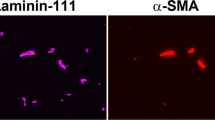Summary
We have detected fibroblast growth factor receptor (FGFR) gene expression in the focal ischemia model. The FGFR gene expression in neurons can be explained by neuronal network disturbances, but the mechanism of astroglial gene expression remains uncertain. We speculated that blood-borne edema fluid may activate gene expression of astroglias. To prove this hypothesis, we compared the pattern’s of gene expression of FGFR and distribution of edema fluid by using serial tissue sections of the middle cerebral artery (MCA) ischemia.
The left MCA of twenty-four male Wistar rats were occluded, and sacrificed 1, 3,4, 7 and 14 days later by transcardiac perfusion and fixation. The tissues were sliced thinly to 14 jam sections. Part of the tissue sections was used for in situ hybridization for rat FGFR with [35S]labeled RNA probes. The other part of the sections was used for immunostaining for albumin, immunoglobulin G (IgG) and IgM.
The FGFR mRNA expression was evident in the lesion-side hemisphere. In the cortex, neurons mainly expressed FGFR gene in the cortex, whereas astroglias and capillary endothelium expressed FGFR in the corpus callosum and internal capsule. The albumin distributed cortex and white matter of the lesion-side and it extended to the contralateral side. The IgG distributed mainly in the lesionside white matter, and in part extended to the contralateral side. The IgM only distribute to the infarcted area. When we compared topographical distribution of FGFR in the white matter and pattern of albumin, IgG and IgM distribution, pattern of IgG distribution correlated well to the area of FGFR expression.
The results indicate that blood-borne macromolecules distribute to the periinfarcted brain tissue depending on their molecular size and the FGFR gene expression might be activated by blood-borne macromolecules with molecular weights similar to IgG.
Access this chapter
Tax calculation will be finalised at checkout
Purchases are for personal use only
Preview
Unable to display preview. Download preview PDF.
Similar content being viewed by others
References
Kataoka K, Hayakawa T, Yamada K, Mushiroi T, Kuroda R, Mogami H (1989) Neuronal network disturbance after focal ischemia in rats. Stroke 20: 1226–1235
Kataoka K, Hayakawa T, Kuroda R, Yuguchi T, Yamada K (1991) Cholinergic deafferentation after focal infarct in rats. Stroke 22: 1291–1296
Sakaguchi T, Wanaka A, Yamada K, Kohmura E, Taneda M, Tohyama M, Hayakawa T (1991) Expression of bFGF receptor mRNA in the central nervous system with ischemic injury. Adv Neurotrauma Res 3: 53–58
Wanaka A, Johnson EM Jr, Milbrandt J (1990) Localization of FGF receptor mRNA in the adult rat central nervous system by in situ hybridization. Neuron 5: 267–281
Wilkinson D G, Peters G, Dickson C, McMahon A P (1988) Expression of the FGF-related proto-oncogene int-2 during gastrulation and neurulation in the mouse. EMBO J 7: 691–695
Yamada K, Kinoshita A, Kohmura E, Sakaguchi T, Taguchi J, Kataoka K, Hayakawa T (1991) Basic fibroblast growth factor prevents thalamic degeneration after cortical infarction. J Cereb Blood Flow Metab 11: 472–78
Author information
Authors and Affiliations
Editor information
Editors and Affiliations
Rights and permissions
Copyright information
© 1994 Springer-Verlag
About this paper
Cite this paper
Yamada, K. et al. (1994). Blood-Borne Macromolecule Induces FGF Receptor Gene Expression After Focal Ischemia. In: Ito, U., et al. Brain Edema IX. Acta Neurochirurgica, vol 60. Springer, Vienna. https://doi.org/10.1007/978-3-7091-9334-1_69
Download citation
DOI: https://doi.org/10.1007/978-3-7091-9334-1_69
Publisher Name: Springer, Vienna
Print ISBN: 978-3-7091-9336-5
Online ISBN: 978-3-7091-9334-1
eBook Packages: Springer Book Archive




